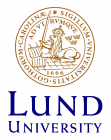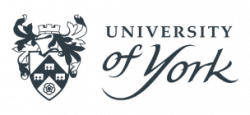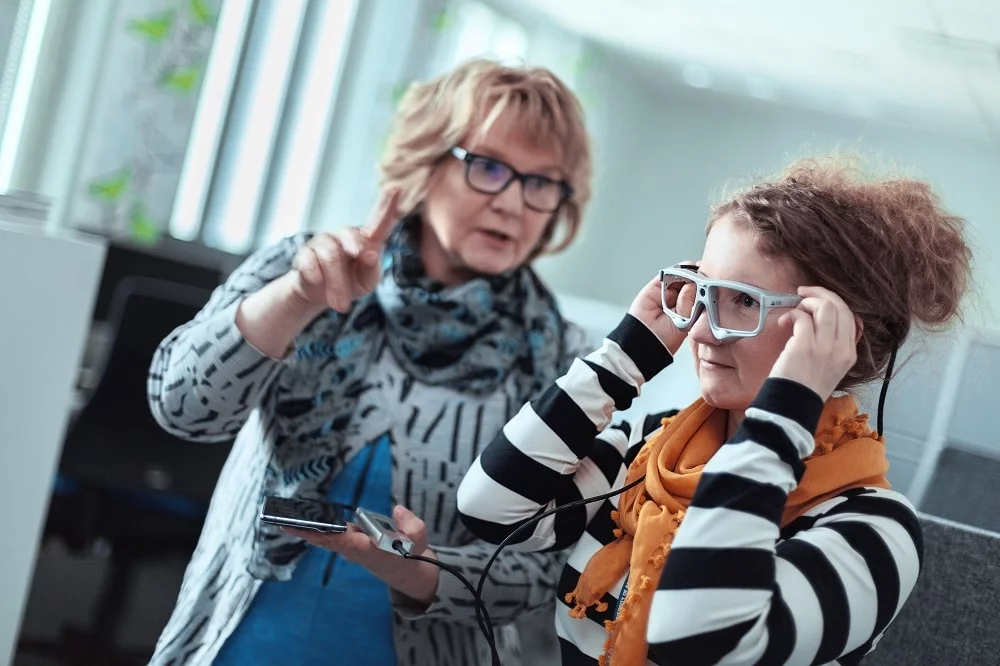
TINEL


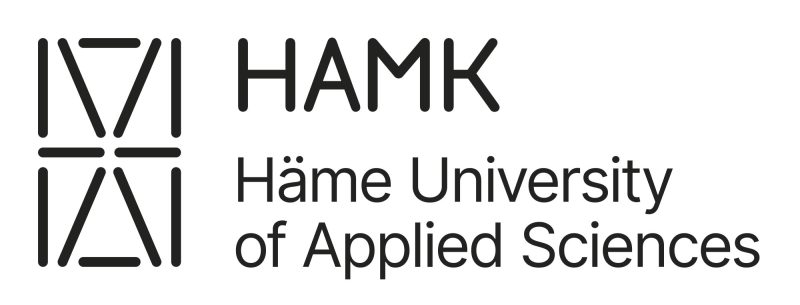
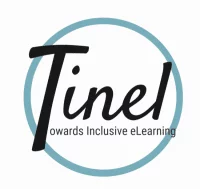
Project Information
| Project | TINEL |
| Duration | 1.10.2018-31.12.2021 |
| Partners | The Association of Finnish eLearning Centre (NGO), University of Jyväskylä Lund University Norwegian University of Science and Technology (NTNU) University of York Häme University of Applied Sciences (HAMK). |
| Funding | The Erasmus+ |
Towards Inclusive eLearning: Improving Accessibility of eLearning in Higher Education from Universal Design for Learning perspective.
The overall ambition of TINEL was to contribute in a shift from the notion of accessibility for separate so called “vulnerable” or “disadvantaged” groups to an inclusive mindset based on Universal Design for Learning (UDL) thinking. The project improved inclusive eLearning from UDL perspective by producing new knowledge for greater understanding and responsiveness to social, ethnic, linguistic and cultural diversity on three levels: 1) inclusive eLearning practices and use of UDL in facing different needs of higher education students on national and transnational levels; 2) innovative pedagogical and technological skills and support network for educators; 3) a training model to begin sensitizing faculty and staff on the issues for designing inclusive e-learning within the context of UDL.
The project was carried out in cooperation between six partners, one NGO and five higher education institutions from Finland, Sweden, Norway, and United Kingdom. The project objectives were: 1) to map and explore inclusive practices of eLearning and implementation aspects of UDL in HEIs 2) to develop an evaluation tool and a training model for improving eLearning accessibility from UDL perspective 3) to develop pedagogical and technological skills of staff for improving inclusive eLearning from UDL perspective.
Main project activities were: 1. Joint Open Call for submission of The Best inclusive eLearning and UDL practices in HEIs; 2. Transnational Best Practices Conference on inclusive eLearning and UDL; 3. Developing an Evaluation Tool and a Training model for inclusive eLearning and implemented UDL along with processing cases from each participant HEIs; 4. Teaching staff and processing UDL cases at Camps followed by Webinars and workshop sessions; 5. Producing UDL learning material to support the training process described above; 6. Transnational Closing conference.
The Erasmus+ funded project was carried out during 1.10.2018-31.12.2021 in cooperation between six partners, The Association of Finnish eLearning Centre (NGO), University of Jyväskylä from Finland, Lund University from Sweden, Norwegian University of Science and Technology (NTNU) from Norway and University of York from United Kingdom. The project was coordinated by Häme University of Applied Sciences (HAMK).
Target Group
The overall ambition of TINEL was to contribute in a shift from the notion of accessibility for separate so called “vulnerable” or “disadvantaged” groups to an inclusive mindset based on Universal Design for Learning (UDL) thinking.
Target Area
The project improved inclusive eLearning from UDL perspective by producing new knowledge for greater understanding and responsiveness to social, ethnic, linguistic and cultural diversity on three levels.
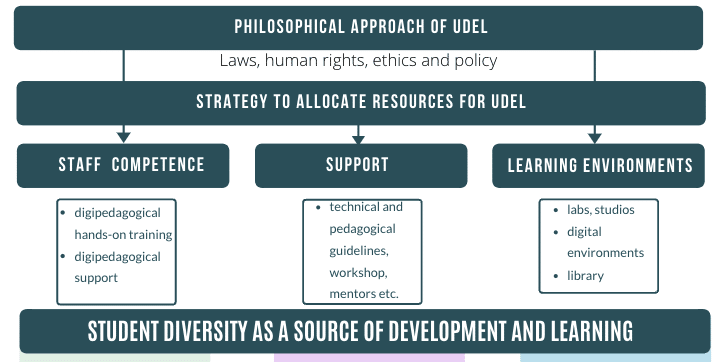
This Tool was originally developed only for self-evaluation purposes of Camp participant’s UDeL cases, and to be used for process evaluation and for getting feedback throughout the course of running the case.
The UDeL Context Cards are part of the staff training material developed during the TINEL Project. They show a wide variety of situations a proactive teacher can prepare for.
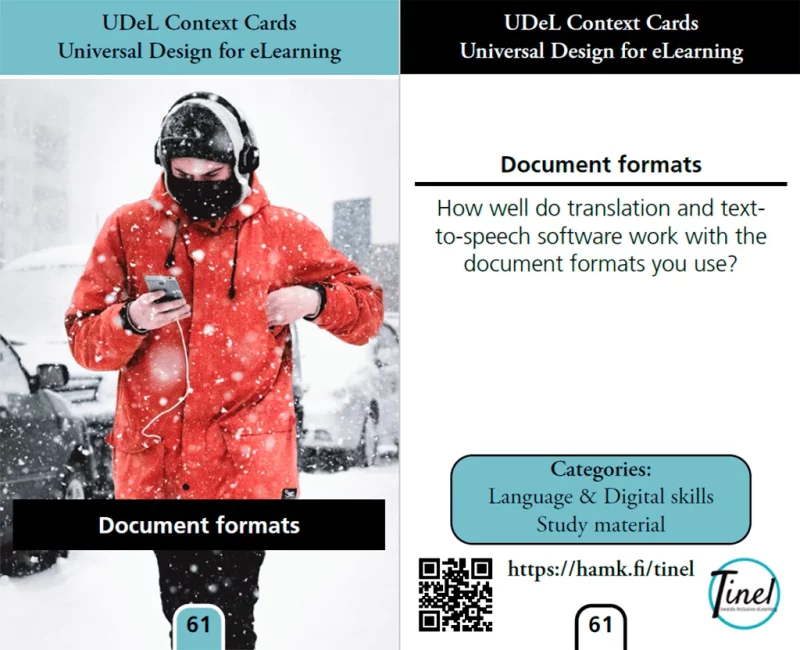
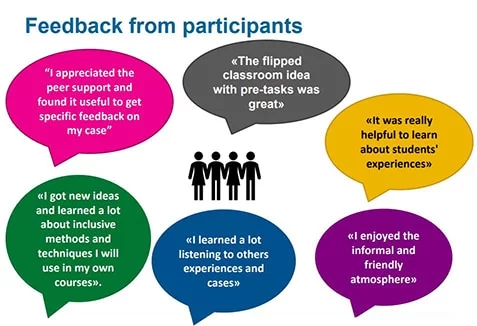
The core of the TINEL training model is the UdeL camps, where staff at higher education institutions discuss the challenges facing diverse students and how to support them.
About UDL and UDEL
What is UDL and UDeL?
UDL (Universal design for learning) is a framework that provides scientific guidelines for design and development of curriculum. UDL is focused to make learning accessible for all. UDeL (Universal design for e-learning) has the same guidelines but they are focused to make e-learning more accessible for all.
Intro 2 to Inclusive learning and UDeL
In this introduction video 2 Elinor J. Olaussen, Senior Adviser from Universell, Norway presents from the UDeL perspective the concepts of universal design, universal design of ICT and universal design of learning (UDL) as well as related international regulations.
Universal Design is a framework originally created to make products and buildings accessible for all. The most used definition is from the UN Convention on the Rights for People with Disabilities (CRPD:2008):
“Universal design” means the design of products, environments, programmes and services to be usable by all people, to the greatest extent possible, without the need for adaptation or specialized design. “Universal design” shall not exclude assistive devices for particular groups of persons with disabilities where this is needed.
It is important to understand the ideas of universal design before we try to implement these ideas in a learning context. So how do we use these thoughts and this definition to plan for a diverse student population? What will the practical implications be for students and staff working in higher education?
Universal design of the physical learning environment is quite easy to understand. As an example, entering a higher education building should be possible for all. The entrance should be easy to find, without any obstacles or physical barriers, with automatic door openers and with good contrasts at the door. This is the same entrance for everyone, regardless if you use a wheelchair, have your hands occupied with books and study material, or if your hand function is reduced. In a university campus, universal design should be the strategy for forming the physical environment everywhere. Universal design of the digital learning environment has more recently emerged as a strategy in planning for the use of ICT in an educational context. General information, learning management systems, literature and other digital study material should be presented in accessible formats, and in compliance with standards that include students with difficulties in accessing digital study material. For example, a video used for learning reasons should be captioned to the benefit for the hearing impaired, and better quality for all students.
Universal design for learning (UDL) is a framework for instruction, dialogue and learning, which uses the principles from both universal design and from learning science and neuroscience. The result is scientific guidelines for design and development of curriculum – learning goals, means of assessment, teaching methods and learning materials – that are inclusive and valuable for all learners.
The development of guidelines will promote an educational practice that provides variation and flexibility in the way information is presented, in the way students respond or demonstrate knowledge and skills, and in the way students are engaged in their learning process.
UDL will reduce barriers in all kinds of instruction, and provide support and challenges to the diversity of learners, regardless of disabilities of any kind. The UDL principles will be important to the development of new teaching and learning methods, and affect how we look at teaching in the classroom, in group activities at campus, and at all kinds of digital learning, as well as at assessment.
All learners are different, they learn differently and the diversity that truly exists in your class is a normal variability that actually reflects the population. The differences in how students learn are expanding, and the context – the learning environment – is itself complex and dynamic. UDL addresses the variations between the learners and focuses on the learning process by providing
- Multiple means of engagement
- Multiple means of representation
- Multiple means of action and expression
In this context, the differences between students in any context is an actively positive force in learning. UDL will provide an approach for designing learning environments that support high expectations and results for all students
.
Open call
The first objective of the TINEL project was to map and explore inclusive practices of eLearning and implementation aspects of UDL approach in higher education institutions. For these purposes, an open Call for Submission was announced 2019. From all proposals four were selected and compiled to a freely available corpus of best practices to help staff in higher education institutions to support the widest diversity of students, regardless of backgrounds, experiences, learning styles and abilities. The four chosen best practices are:
- FIN, Aalto University: Nordic Rebels: A Blended Approach to Fix Higher Education
- NO, University of Agder: Digital competency – An introductory course to digital tools for education and collaboration
- FIN, HAMK: The Video Documentary “Songs from the Life” as a part of final thesis of three students (Bachelors of Social Services)
- FIN, University of Jyväskylä: Crossing borders without travel: Virtual exchange practices for student.
The case Crossing borders without travel describes a top-down, proactive approach. The initiative originates at the department level, which encouraged the teacher to introduce the possibility of virtual exchange (VE) visits as well as physical exchange visits into a campus-based course. The case considers students who are able-bodied as well as students with different challenges. Students have a possibility to gain experience from intercultural dialogues with students from different countries. The common way is study exchanges, but this is not a preferred solution for all students for financial, family, work, personal or health reasons. Students might not be able to afford such a visit, or are too shy, to go abroad for a long period, or circumstances could be such that they need to work or take care of a family member at home. VE was the solution to this problem, changing the course from being only campus-based to be a blended learning course with a multitude of interaction possibilities between students. The focus from the teacher is pedagogic solutions and accessible technology, which is decided between collaborating students from different countries.
The case Nordic Rebels has a more philosophical and reflective perspective about how students learn in society and furthermore how university courses and pedagogy should change from being lecture-based to being student-focused, by creating meaningful learning experiences for all students. Blended learning and flipped classroom methods are presented as good examples of how technology can help in going this direction. The case describes a top-down, proactive approach at the societal and course levels, and portrays UDL as a solution and an aid to understanding academic diversity and individual differences among students, for example a “mixture of nationalities, genders, disciplines and prior work experience” as well as considering “students working alongside their studies” and being able to study at their own pace, due to varying English skills or prior experience in the subject. Also, by giving the students a sense of course flexibility, the teacher can lower the threshold and allow the students to suggest course changes that support their learning.
The case Digital competency provides a proactive approach to UDeL at course level. Teachers planned and thoroughly tested the accessibility of a new eLearning course with a target group of students who have challenges with sight, hearing and language. The focus was largely on technical accessibility of the learning platform and content and on a diversity of students with disabilities.
The case Songs from life describes the teacher-student level approach in which the teacher needs to react to a problem that arises during a course to accommodate a specific student situation. This situation was not planned or predicted before the start of the course, but the teacher became aware of a situation and a specific pedagogical solution for a student with difficulties in concentration and textual expression. The solution was to allow the student to make a video documentary. Further on, this could be planned as an alternative for all students when the course is given again. This is one way of moving towards UDL step by step. When a teacher becomes aware of a student’s preferences, the solutions to this increased diversity will be consciously planned in the future to improve the course for all students.
Read more about the rewarding of best practices
.
Conferences
Only online, 8.-9.12.2021
Organised by the University of York, United Kingdom
The coronavirus pandemic has thrown many higher education institutions (HEIs) headlong into e-learning and greatly increased the emphasis on blended learning, for both the short and longterm.
How have students with disabilities, students from a diversity of backgrounds and living circumstances coped with this situation and how have HEIs supported them? What has worked, what has not worked, what are the challenges for the future?
The Erasmus+ funded TINEL Project (http://hamk.fi/tinel) has been investigating universal design for learning in blended and e-learning situations since before the pandemic hit. Our work has become even more relevant since the pandemic.
The Conference
In December we will host a conference to share best practices and challenges for the future in supporting a diversity of students in the post-pandemic era of blended and e-learning in higher education.
The conference will be a mixture of workshops, short presentations from participants and from the TINEL team about the work of the project. There will be plenty of time to network and we aim to start an ongoing support network of staff from HEIs to continue the discussion of these issues after the conference.
Abstracts and presentations (recordings and/or pdf:s of PowerPoints) at the TINEL Closing Conference
- TINEL Project presentations:
- Participants´abstracts and recordings
- A special issue of the journal Interacting with Computers will be organized, with presenters invited to submit longer versions of their paper.
Proceedings
We will publish an online proceedings of all the conference presentations. The online proceedings will comprise the abstracts and optionally a captioned recording of the presentations at the conference.
A special issue of the journal Interacting with Computers (https://academic.oup.com/iwc) will be organized, with presenters invited to submit longer versions of their paper.
If you have any questions, contact the organizer in your country (or Helen Petrie for all other countries):
Finland: Merja Saarela, HÄME University of Applied Science (merja.saarela(at)hamk.fi)
or Tarja Ladonlahti, University of Jyvãskylã (tarja.ladonlahti(at)jyu.fi)
Norway: Anne-Britt Torkilsby, NTNU (anne.torkildsby(at)ntnu.no)
Sweden: Håkan Eftring, Lund University (hakan.eftring(at)certec.lth.se)
UK (and other countries): Helen Petrie, University of York (helen.petrie(at)york.ac.uk)
Conference invitation (PDF)
Keynote speaker
Addressing the needs of diverse learners in online and blended learning with Universal Design for Learning in the post-pandemic Academy: opportunities, new alliances, hurdles, shifting ground, U turns, quick sands, and other surprises of the journey
Bio:
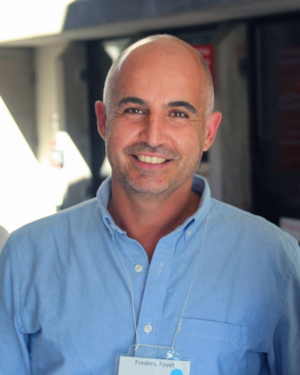
Frédéric Fovet is Associate Professor in the School of Education and Technology at Royal Roads University. He has previously held the position of Assistant Professor within the Faculty of Education of the University of Prince Edward Island. Over the duration of his PhD., he was Director of the Office of Students with Disabilities at McGill University. He has also served as a teacher and principal in the K-12 sector.
He is an inclusion specialist with a specific interest in social, emotional and behavioural difficulties (SEBD), critical pedagogy and universal design for learning (UDL). Frederic also has a strong grounding in
Disability Studies. He acts as a consultant, both nationally and internationally, in the area of UDL and inclusion – in the K-12 and the post-secondary sector. He was the instigator and program chair of the first three pan-Canadian conferences on UDL in 2015, 2017 and 2019.
Welcome to the Best Practices in Universal Design for eLearning in Higher Education conference!
Join us in this great opportunity to have innovative discussions about Universal Design for eLearning (including blended learning) in higher education. Over two days you will learn more about good educational and accessible practices from many higher education institutions and many countries including Finland, Sweden, Norway and United Kingdom. You can also share your own ideas and initiatives related to this topic in our poster sessions.
During Spring 2019 the TINEL project organized an Open Call for the best inclusive and flexible eLearning or blended learning practices in higher education. At the conference, the best initiatives and practices from this call will be presented, followed by a publication.
Quality Education for all!
Conference programme is free of charge.
Training model
What is the TINEL training model
The TINEL training model is a framework that has been developed and tested during the Erasmus+ project TINEL (Towards Inclusive e-Learning). The purpose was to find a model for:
- training staff at higher education institutions (HEIs) in inclusive e-learning and blended learning based on the principles of Universal Design for Learning (UDL). As we focus on e-learning, we call it Universal Design for eLearning (UDeL).
- creating an international peer support network for staff interested in inclusive teaching and Universal Design for eLearning.
The TINEL training model uses other results developed at the TINEL project:
- Learning materials consisting of videos with experience from students and teachers, articles with teachers’ experience from development projects, UdeL Context Cards showing situations a proactive teacher can prepare for, and participants’ case studies from the UdeL “camps” run during the TINEL project.
- The Enhancement-Led self-Evaluation Tool (ELET) for structuring everyday practices and reflecting on their effectiveness with peers.
You find them under the section “Learning materials” and “Enhancement-Led self-Evaluation Tool”.
Do you want to improve your staffs’ knowledge about Universal Design for eLearning?
Then have a look at the components of the TINEL training model below, how we organised activities for staff in higher education institutions (including invitation letters and agendas), the Learning materials and the Enhancement-Led self-Evaluation Tool we have developed and how we used them. You are free to adapt and use the documents for your own activities.
Within the TINEL training, new knowledge for greater understanding and responsiveness to social, ethnic, linguistic and cultural diversity were provided for staff on three levels: 1) tryout inclusive eLearning practices and use of UDL in facing different needs of higher education students on transnational and national levels; 2) inspire with innovative pedagogical and technological skills, and support network for educators; and 3) overall to begin sensitizing faculty and staff on the issues for designing inclusive e-learning within the context of UDL. Here is an overview of the TINEL training model and its components of the training model.
- Participants cases – Develop UDeL practices and learning with their own cases
- Camps – face to face or online
- From 3 full days to 5 half days
- Flipped classroom – prerecorded learning material
- Learning material
- Maintain and prioritize social activities (ex.Pizza party)
- Webinars with Peer Support
- Follow-up with international webinar and national webinar
Peer support network
- Previous participants help recruiting other participants
- Colleagues collaborate on cases – makes dissemination easier
- Participants as Peer Support Network
- Participants from previous camps were invited for follow-up webinars
- Sharing of resources is easier online
- Arrange national webinars to create support networks at each partner institutions
The core of the TINEL training model is the UdeL camps, where staff at higher education institutions discuss the challenges facing diverse students and how to support them. We have run four UDeL camps during the TINEL project. The first camp was held face-to-face for three days, but due to the Corona pandemic the last three camps was held online for five half days. Moving them online, made them also more relevant to the e-learning topic.
Altogether, 35 staff members at higher education institutions participated in the UDeL camps. They were from Finland, Norway, Sweden and the UK. Each participant brought their own case study to the camp, that could be discussed and progressed.
The purpose of the UDeL camps was to bring HEI staff together and, by creating a welcoming atmosphere, encourage the participants to discuss their real challenges and thoughts about their cases. By connecting the new UDeL knowledge from the camps to their own teaching practices, we aimed at creating deep knowledge that would stay for a longer time. Furthermore, by including social activities at the UDeL camps, we lowered the threshold for discussion and contacting each other after the camps, with the purpose of creating an international peer support network for UdeL.
You can read about the successful UDeL camp activities and our experience from moving them from face-to-face to online camps in the UD2021 conference article below. The activities can also be found in the agenda for the camps. Below, you also find the invitation letter to the camps. You can adapt the agenda and the invitation letter to your own preferences if you plan to run similar camps at your higher education institution.
- UD2021 article: “From Face-to-face to Online UdeL Camps: Supporting Staff at Higher Education Institutions in Developing Universal Design for eLearning (UdeL)”
- Agenda for the UdeL camps
- Introduction letter for the UdeL camps (Swedish, English)
- Workshop activities supporting Universal Design for eLearning (UDeL) in Higher Education Institutions
To create an even larger peer-support network, the TINEL project has run national webinars where the TINEL project, Universal Design for eLearning, and some UDeL camp participants case studies were presented to a wider audience.
Here are the invitations, agendas and presentations at the first and second Finnish webinars and the Swedish-Norwegian webinar.
- Agenda for the 1st national webinar in Finland
- Invitation for the 2nd national webinar Finland
- Agenda for the 2nd national webinar in Finland
- Invitation and agenda to the bi-national webinar in Sweden/Norway
Learning materials
The TINEL project has developed learning materials to be used for training staff at higher education institutions in inclusive teaching and Universal Design for eLearning (UDeL). The learning materials have been developed iteratively and tested during four Universal Design for eLearning (UDeL) camps with participants from Finland, Norway, Sweden and the UK. In addition to the learning materials used at the UDeL camps, participants also learned a lot from other participants’ experiences and case studies and related discussions.
The learning materials consist of:
- Text introduction to Universal Design for Learning and eLearning
- Video introductions to Universal Design for Learning and eLearning (UDL and UDeL)
- Video with an introduction to how to make accessible documents and videos (Kjetil Knarjak, Helen Petrie)
- UDeL Context Cards showing a wide variety of situations a proactive teacher can prepare for (see below)
- Videos with student experiences and perspectives of inclusive teaching (see below)
- Videos and articles with staff experiences of inclusive teaching (see below).
- TINEL Learning material by eOppimiskeskus
- Analytiikka opetuksessa (in finnish)
The articles can be used in staff training courses when the participants do not have prior experience of inclusive teaching. Instead of just discussing the topic, participants could prepare for a discussion by choosing to read one of the articles and present it to the other participants. This will create discussions about the article in relation to the participants own experiences and create a deep learning about the topic.
We have also collated links and other kind of resources (videos, articles and websites) that can be used as learning materials.
As a staff member it is important for you to learn more about student perspective. It is very important to develop the education together with the students. Students are often the best specialists of their learning and it is very useful to hear their voices and listen to their experiences. Accessible education was the main goal behind the TINEL project. During the project, project partners and participants of the camps had close connections with diversity students.
See following video examples of students, who are willing to share their experiences as a higher education student. Some of them are produced during the project while some are shared in internet. Please remember that every story is unique, and all the students are different. As one student with dyslexia said: this is how I learn best, but it does not mean that it is the best way for all the students with dyslexia.
The following videos 1-4 present students’ perspective on how personal challenges have impacted their studies in a higher education institution. The following videos 5-8 present teachers’/ professional’s perspective on what to think about universal design of studies in higher education institutions. All the videos give an idea of how to think flexibly both in relation to role as a student and as a other actor in a higher institution organization and what kind of possibilities it exists to create diverse studying opportunities.
Video 1 (Gagan)
In the video ‘Being a Student with Visual Impairment’ Gagan Chhabra shares his critical thoughts about the concept of an average/normal student and what kind of perceptions do we often relate to an individual student in relation to other students and what kind of challenges this may create.
Video 2 (Malin)
In the video ‘Being a student with dyslexia’, Malin Cronquist, diagnosed with dyslexia, tells about her university studies at Lund University, her challenges in studies, what helpful tools she uses and what kind of support she receives from the university in her studies. She also shares her challenges in everyday life.
Video 3 (Gagan)
Universal Design of a learning environment: A Journey and not a Destination!
Video 4 (Sanna)
In the video Sanna Paasonen, the deaf-blind student, is telling about her university studies at Jyväskylä University, her challenges and what kind of support is helpful for her.
Video 5 (Nora)
Nora Tomas, a student with a disability at Norwegian University of Science and Technology, talks about her experiences with flipped classroom as a means for inclusion. This video was developed and published by Universell as a part of other Erasmus + project.
Open Call for Best Practice – winners
As a part of TINEL Erasmus+ project, a “Call for Best Practice Proposals for Higher Education Institutions” was launched to present the current best practice initiatives for inclusive and flexible education in eLearning and blended learning. Four out of the nine proposals were extended into articles, providing an overview of the current landscape of UDeL in higher education. These articles reflect the diversity of UDeL cases as they represent number of different dimensions: from student diversity to strategic and organisational levels. Introduction for these articles is written by project partners.
The collection includes the following articles:
Háhn, J. 2019. Crossing Borders Without Travel: Virtual Exchange Practices for Students.
Lehtonen, M. J., Chew, J. Y., Schilli, K. S., & Varadarajan, A. 2019. Nordic Rebels: A Blended Approach to Fix Higher Education.
Matre, M. E., Andersen, R., Thormodsæter, M. S., & Cifuentes, M. O. 2019. Digital Competence – Providing Tools to Create an Inclusive eLearning Course.
Romppanen, M. 2020. “Songs of Life” – Video-documentary as a part of Bachelor’s Thesis.
Source: https://unlimited.hamk.fi/universal-design-for-learning-udl/#.YW1u2xpBw2w
Video 6 (Gagan)
In the video ‘Critical Reflections of Being a Professional with Visual Impairment’ Gagan Chhabra tells about how he has experienced the concept of impairment in different roles as a lecturer, a public speaker and a researcher. He tells by examples how this concept looks different depending on which role you are playing and what kind of questions arise in diverse situations.
In the video ‘Universal Design of a learning environment: A Journey and not a Destination!’ Gagan Chhabra tells about his opinions on how we should understand the universal design of learning environment and related aspects of diversity. He also talks about how we should approach the concept of inclusive learning environment.
Video 7-8 (Lars & Lotta)
In the videos ‘Experiences from UDeL Camp’ Lars Harrysson (from Lund University) and Lotta Åbjörnsson (from Lund University) tell their personal experiences from the UDeL Camp. They share their reasons and incentives why they attended the UDeL camp as well as their opinions of the practical relevance of UDeL.
Technology always involves technology itself, how to use it and how to use it pedagogically wise. Each teacher and each student have their own preferences.
When we are using technology in education, technical accessibility also becomes a focus point. The technology should support multiple means of input and output methods of data to and from devices and programs. This means that technological tools needs to be designed so that they are easy to us and support ready-made tools for accessibility eg. screen readers. Software should also support accessible content creation. This means that it automatically guides content creators to make accessible material eg. to add alternative texts and use the right kind of heading methods.
During the TINEL-camps, we had lots of discussions about the tools we use. Each country has their own preferences and also their own national providers, which don’t provide their services internationally. In the following infographic you will find a palette of tools, which have been tested and found suitable for teachers who want to make their teaching accessible.
Please note that there are new tools and new versions of old ones arriving to markets all the time. Sometimes good features might be removed or replaced and the tool might become old-fashioned. But this is a good list to start making your teaching more accessible.
LINK: https://www.hamk.fi/wp-content/uploads/2024/03/accessibility_apps_multmodal_function.pdf
Networks
As we all know, networks are great place to share ideas and learn new things. Here are few places from where you can start. Please remember that there might already be a national network for UDL or inclusion generally.
Facebook: TINEL group (https://www.facebook.com/TinelProject/ )
Facebook: National Centre for UDL (https://www.facebook.com/UDLCenter/)
The UDeL Context Cards are part of the staff training material developed during the TINEL Project. They show a wide variety of situations a proactive teacher can prepare for. The situations are related to aspects of student diversity, e.g. students with disabilities, students’ personal preferences, students’ family or work situations, financial situations, language skills, prior work experience, and study contexts.
The cards describe situations only – not solutions, as the solutions may vary according to what is possible and appropriate in a specific learning situation. The teacher is encouraged to discuss possible solutions with his or her colleagues.
Download The UDeL Context Cards here:
The diverse situations on the UDeL Context Cards have been collected from participants real cases at the TINEL conference in Jyväskylä, Finland, and the four TINEL UDeL camps. The UDeL Context Cards is based on the Haptimap Context Cards:
- C. Magnusson, A. Larsson, A. Warell, H. Eftring, and P.-O. Hedvall, Bringing the mobile context into industrial design and development, NordiCHI’12: Proceedings of the 7th Nordic Conference on Human-Computer Interaction: Making Sense Through Design. (2012), 149–152.
- Certec (2017). Context Cards and the Haptimap Project. Available at: https://www.certec.lth.se/ud/context-cards-and-the-haptimap-project/ [Accessed 22 March 2021]
How can you use the UDeL Context cards?
There are at least two ways of using the UDeL Context cards:
- In course preparation.
The UDeL Context cards can be used as a tool for teachers to test a course in advance, to see if they have thought of most situations that could occur in a course, especially in relation to student diversity and different learning situations and preferences. You pull a card from the deck, read about the situation, and reflect on how you would handle this situation if it would occur in your course. Think of ways to solve the situation in an inclusive and non-stigmatizing way, e.g. give all students the same opportunity to have an oral exam. You might need to reflect on the learning outcomes of a course, to see if there are any unnecessary obstacles that can be changed. - In staff training workshops.
The UDeL Context cards can be used at staff training workshops to discuss inclusive teaching, by letting some of the Context Cards trigger the workshop participants to suggest new cards based on their own experiences. The workshop participants can then discuss possible solutions. So, the deck of UDeL Context Cards is never complete, and there might be more relevant to discuss new cards related to participants’ own experience from their teaching practice than just studying the existing cards.
If you have suggestions for new Context Cards, please contact hakan.eftring(at)certec.lth.se .
Enhancement-Led Evaluation Tool
Enhancing UDeL in Higher Education Institution with the Enhancement-Led Evaluation Tool
For enhancing UDeL in the higher education institution (HEI), the TINEL project has developed Enhancement-Led Evaluation Tool (ELET). The purpose of the Enhancement-led evaluation is to support HEI to develop activities by providing self-evaluation questions to structure everyday practices and reflect on their effectiveness with peers. A goal-oriented atmosphere of positive change is created by exchanging and disseminating practices with peers. The Enhancement-led evaluation consists of two self-assessment questionnaires: 1) status of HEI’s current UDeL activities, and 2) the enhancement-led self-evaluation form.
Enhancement-led evaluation aims to support HEI to develop practices by self-evaluation and by peer-reviewing [1]. The Enhancement-led evaluation approach has been used over 20 years in the education evaluation activities in Finland. The overall goal of the enhancement-led evaluation is to make current state of HEI’s activities visible and to define future developmental goals. The Enhancement-led evaluation is strongly based on participation and interaction, and thus the evaluation process becomes a joint learning process, in which the interaction between the evaluation participants and their learning from each other supports the change. Staff, students and other stakeholders of a HEI are involved in recognising strengths, good practices and enhancement areas in the HEI’s activities. As a part of self-evaluation, practices with evidence of positive effects are described and presented for peer-reviewing. Sometimes, a practice posses qualities worth for spreading and applying as a good or even best practice for a wider audience inside the HEI. The best practice supports the change in HEI.
Because of good results in developing quality and HEI’s activities in Finland [2] and in Scotland [3], well-defined participatory and interactive evaluation process with characteristics of goal-orientation and futures consciousness, enhancement-led evaluation was found promising to be applied for developing Enhancement-Led Evaluation Tool (ELET) for UDeL. The ELET is a supportive resource for implementing and sustaining UDeL practices. It has distinct focus on UDL in use, and takes on itself to answer questions about how to implement UDL, what factors are important when applying UDL in eLearning, and how the process can be self-evaluated. The ELET consists self-evaluation questions 1) to define the status of HEI’s current UDeL activities, and 2) to self-evaluate own UDeL practices, which may become a good or a best practice for the wider use in HEI as an UDL resource. The ELET was developed to be used for process evaluation and for getting feedback throughout the course of running eLearning cases.
References:
[1] Moitus, S. & Kamppi, P. 2020. Enhancement-led evaluation at the Finnish Education Evaluation Centre. Summaries 11:2020. Finnish Education Evaluation Centre. ISBN 978-952-206-587-2 pdf.
[2] Finnish Education Evaluation Centre. https://karvi.fi/en/higher-education/
[3] Scotland’s Quality Body for Higher Education. https://www.qaa.ac.uk/scotland/en/home
The Tool was originally developed only for self-evaluation purposes of Camp participant’s UDeL cases, and to be used for process evaluation and for getting feedback throughout the course of running the case. Later, during the TINEL project, we realized that although UDL understanding and skills of an individual teacher are important, they are not sufficient to enhance equally versatile student learning perspectives at HEI in large.
The first part of the iteration process of a Tool was done 2018-19 alongside with the international Open Call for the best UDL practices in Higher Education (HE). Self-evaluation questions for the Tool were applied and modified from the Finnish enhancement-led evaluation audit material [1]. Self-evaluation questions were addressed and properties of the tool developed by forming an Entry Form for the Open Call of best UDL practice cases. Based on experiences of Open Call and by processing self-evaluation questions further on at the international workshop of Best Practice Conference in Jyväskylä, self-evaluation questions were formed as a Enhancement-Led Evaluation Form.
The basis for another part of the Tool, self-evaluation of the status of UDeL at the HEI, was modified from results of the Open Call. Further iteration was done alongside with Camps and participants’ redesign tasks. Self-evaluation questions have basis on the Finnish enhancement-led evaluation audit material from which they were modified with a representative of FINEEC5.
The pressure for enhancing UDL approach at HE comes from ethical, human rights and legal perspectives. The higher education (HE) as a public service is morally obligated to consider strategic approach to set goals and allocate resources to enhance UDL and accessibility by large, to ensure equal learning rights for diversity of students. More inclusive policy and practices will enhance access, participation and learning performance of disadvantaged learners and may reduce disparities in learning outcome. According to research [2]-[7], applying UDL to teaching has positively contributed to student learning experiences, experiences of performance, commitment, satisfaction, and social presence, as well as alleviation of learning stress. So, widely used UDL framework alongside with accessible eLearning pedagogy, tools and environment provides access to learning to the widest possible audience by removing potential barriers, offering flexible paths and timely support to learning.
References:
[1] Audit manual for Higher Education Institutions. https://karvi.fi/app/uploads/2019/09/FINEEC_Audit-manual-for-higher-education-institutions_2019-2024_FINAL.pdf
[2] Davies, P. L., Schelly, C. L., & Spooner, C. L. 2012. Measuring the effectiveness of Universal Design for Learning intervention in postsecondary education. Journal of Postsecondary Education and Disability, 26(3), 195–220.
[3] Draffan, E. A., James, A. and Martin, N. 2017. Inclusive Teaching and Learning: What’s Next? Journal of Inclusive Practice in Further and Higher Education 9 (1) pp 23-34.
[4] Firchow, N. 2016, March 11. Universal Design for Learning — improved access for all. Retrieved from: https://www.greatschools.org/gk/articles/universal-design-for-learning-improved-access-for-all/
[5] Fornauf, B. S. & Erickson, J. D. 2020. Toward an Inclusive Pedagogy Through Universal Design for Learning in Higher Education: A Review of the Literature. Journal of Postsecondary Education and Disability, 33(2), 183-199.
[6] Kumar, K. L., & Wideman, M. 2014. Accessible by design: Applying UDL principles in a first year undergraduate course. Canadian Journal of Higher Education, 44(1), 125–147.
[7] Rose, D. H., & Strangman, N. 2007. Universal design for learning: Meeting the challenge of individual learning differences through a neurocognitive perspective. Universal Access in the Information Society, 5(4), 381–391. doi:10.1007/s10209-006-0062-8.
The planning and implementation of HE is determined by a diverse student body. Students diversity poses challenges for pedagogy, but serves also as a source for pedagogical development and innovations. As the ELET provides two perspectives to self-evaluate, 1) the status of HEI’s current UDeL activities and 2) training participant’s own UDeL practices – there are different ways to implement it at TINEL Training process.
1) The status of HEI’s current UDeL activities. The first part of the Tool, the status of HEI’s current UDL activities, is useful at the beginning of the UDeL training process. Before deciding and defining the case for learning and applying UDL principles, it is useful to clarify for oneself a bit of the current state of HEI’s strategic, management and pedagogical views for tackling student diversity issues, flexible study paths for ensuring the progress of studies for all students. In defining the UDeL case for learning, it is also useful to map HEI’s technological and pedagogical resources that are available for supporting design of learning environments, accessible materials and learning assignments.
How to do the self-evaluation in practice? Arrange a joint meeting with your team to discuss and reflect on the self-assessment questions of the first part of the Tool. If possible, bring your supervisor with you. Based on your discussion, compile a summary of the current state of your HEI into a word document, for example. It is important, that you all share a common understanding of how things are at your HEI concerning UDeL, what kind of resources and support is available for staff to succeed and develop with teaching and learning.
2) Enhancement-Led Self-evaluation form for the training participant. One component of the TINEL Training Model is redesign task. In redesign task the participant of the training will apply learned UDL theory into practice with own UDeL case. Enhancement-Led self-evaluation form can be used at the beginning of the training process and after the redesign case is finished. Self-evaluation questions of the Form are helpful in structuring the challenge of an everyday practice, in defining UDL redesign acts and purposes, in reflecting applicability and to define or observe expected effect on students learning behavior.
How to do the self-evaluation in practice? There are two kind of questions on a form: boldly written main questions and assistance questions under them. Concentrate on bold self-evaluation questions. Assistance questions are helping you to think reflect main questions.
- In case of using the self-evaluation form from the start of the UDL training, self-evaluation questions are giving you ideas to focus on certain aspects of your case in defining the redesign task. As the UDeL training continues forward, and you share your case with other participants and get feedback from others, you can come back to your case and continue deepening your understanding and practical matters of implementing it. Also, self-evaluation questions provides you useful structure to present your case for others and to give feedback for others as well.
- In case of using the self-evaluation form at the end of the training process, it can be used for purposes of structuring and packing the practice into a good or a best practice. Eventually, you can collect all your HEI’s UDeL cases into one place to create a source of UDeL good or best practice cases. A goal-oriented atmosphere of positive change is created by exchanging and disseminating good practices with peers.
Contacts
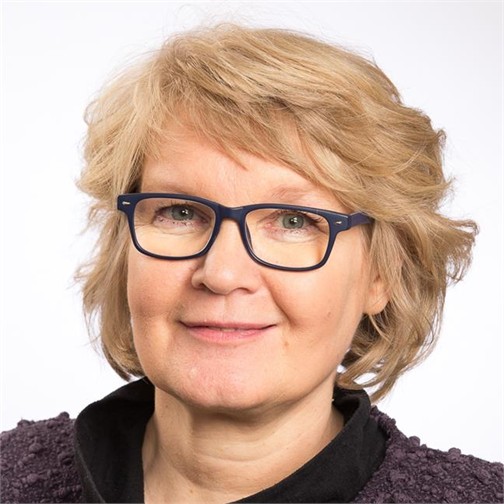
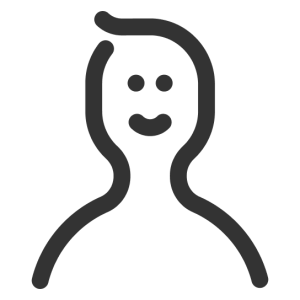
Kaisa Honkonen
Association of Finnish eLearning Centre
kaisa.honkonen@eoppimiskeskus.fi

HELEN PETRIE
University of York
helen.petrie@york.ac.uk

HÅKAN EFTRING
Lund University
hakan.eftring@certec.lth.se

ANNE TORKILDSBY
anne.torkildsby@ntnu.no

TARJA LADONLAHTI
University of Jyväskylä
tarja.ladonlahti@jyu.fi
